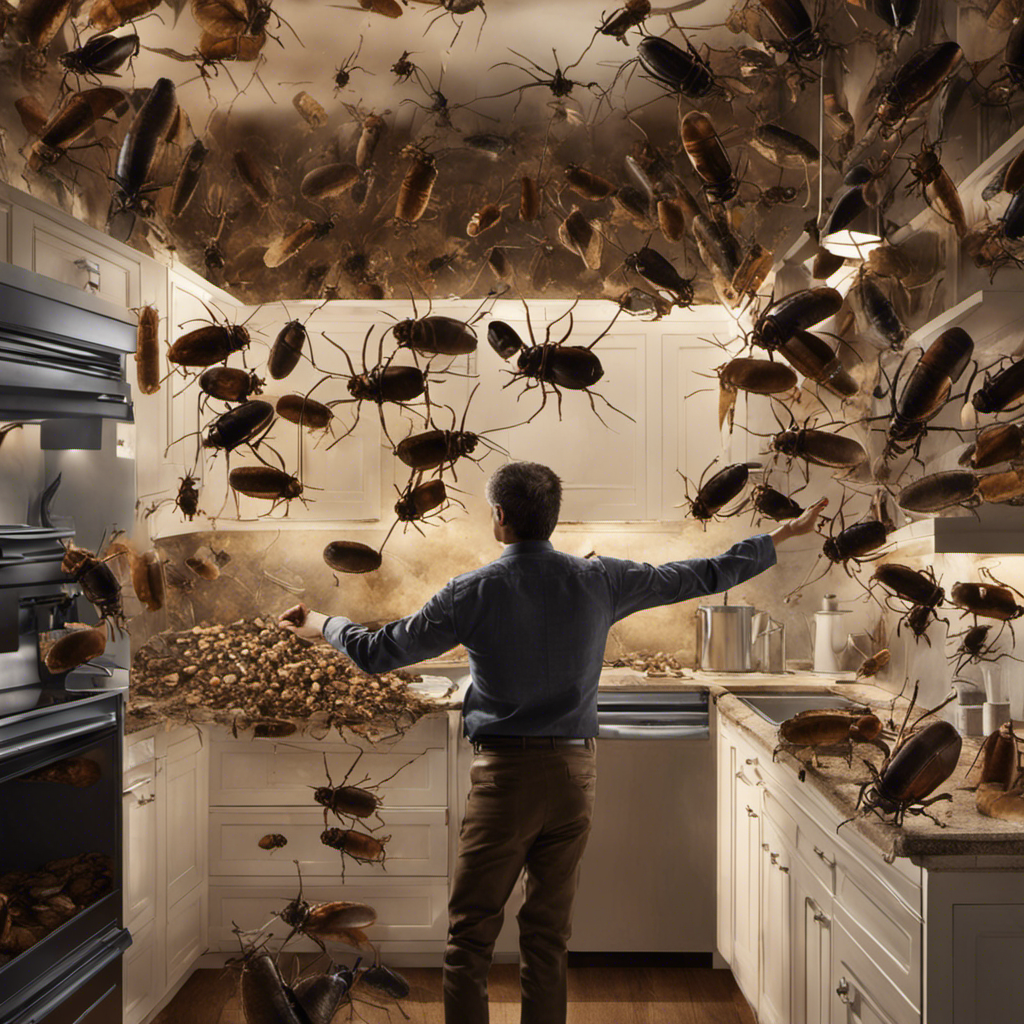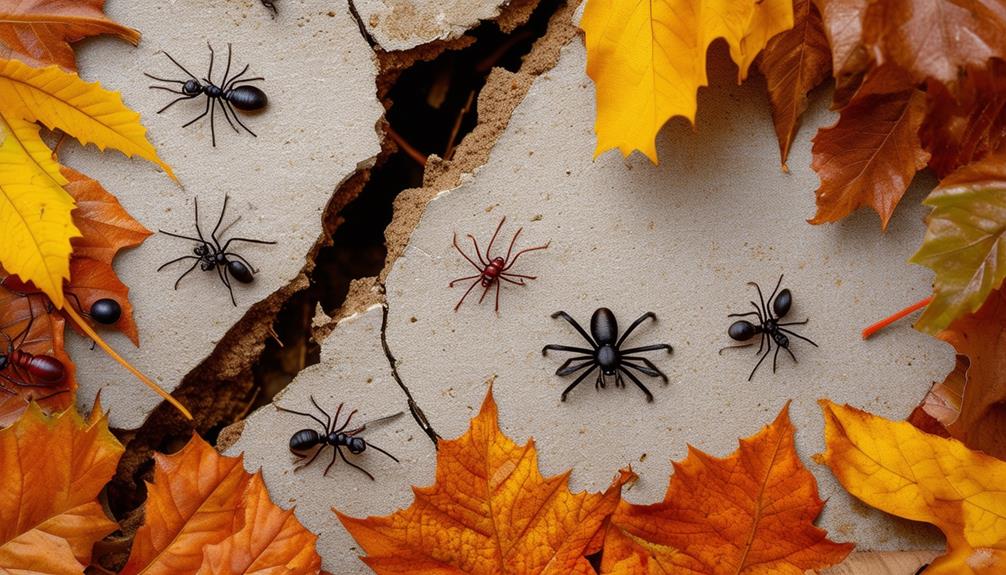This article aims to explore the phenomenon of suddenly observing the presence of large roaches in one’s surroundings. The presence of roaches can be alarming and unsettling for individuals, leading them to question the cause of this sudden occurrence. By examining common causes of roach infestations, identifying different types of roaches, and discussing signs of a roach infestation, this article seeks to provide a comprehensive understanding of the issue at hand.
Additionally, prevention tips to keep roaches at bay, natural remedies for roach control, and the importance of calling in professional pest control services will be discussed. By following these guidelines and maintaining a roach-free home, individuals can take proactive measures to address this issue and ensure a clean and healthy living environment.
This article caters to an audience seeking practical advice and solutions to mitigate the presence of large roaches.
Key Takeaways
- Improper sanitation, presence of food and water sources, and favorable living conditions are common causes of roach infestations.
- Maintaining a clean and hygienic environment, storing food in tightly sealed containers, and promptly cleaning up spills or crumbs can help prevent roach infestations.
- Different types of roaches include American cockroaches, German cockroaches, and Oriental cockroaches, and tailor pest management strategies based on the species.
- Signs of a roach infestation include the presence of roach droppings, a strong musty odor, the discovery of egg cases or shed skins, and roach droppings resembling ground coffee or black pepper.
Common Causes of Roach Infestations
One possible explanation for the sudden appearance of large roaches could be attributed to common causes of roach infestations. These causes typically include factors such as improper sanitation, presence of food and water sources, and favorable living conditions.
Preventing roach infestations requires maintaining a clean and hygienic environment. Roaches are attracted to areas with an abundance of food and water, so it is important to store food in tightly sealed containers and promptly clean up any spills or crumbs. Regularly removing trash and keeping areas free of clutter also helps to deter roaches.
Additionally, addressing any plumbing leaks or moisture problems is crucial, as roaches thrive in damp environments. Understanding the dangers of roach infestations, such as the potential spread of diseases and allergies, emphasizes the importance of proactive prevention measures.
Identifying Different Types of Roaches
To accurately identify various species of roaches, it is essential to familiarize oneself with their distinguishing characteristics. Roach species identification is crucial in understanding roach behavior and implementing effective control measures.
There are several common types of roaches that may infest homes and buildings. The American cockroach, known for its large size and reddish-brown color, is often found in dark, damp areas such as basements and crawl spaces.
German cockroaches, on the other hand, are smaller and light brown in color, commonly infesting kitchens and bathrooms.
Oriental cockroaches are dark brown or black and prefer cool, damp environments like sewers and drains.
By identifying the specific species present, individuals can tailor their pest management strategies accordingly, targeting the roach’s unique habits and vulnerabilities.
Understanding these distinctions is crucial in effectively addressing roach infestations.
Signs of a Roach Infestation
Signs of a roach infestation can include the presence of droppings, a strong musty odor, and the discovery of egg cases or shed skins in areas where roaches are likely to hide and breed.
Roach droppings are small, dark, and cylindrical in shape, often resembling ground coffee or black pepper.
A strong musty odor may be noticed, especially in enclosed spaces like cabinets or behind appliances, as roaches release pheromones that can be detected by humans.
Additionally, the discovery of egg cases or shed skins is a clear indication of roach activity, as these are signs of their reproductive cycle.
To prevent roach infestations, it is important to maintain cleanliness by regularly cleaning and removing food debris, sealing cracks and crevices, and eliminating sources of moisture.
Implementing these roach prevention tips can help mitigate the risk of infestation and ensure a pest-free environment.
Prevention Tips to Keep Roaches at Bay
Implementing effective prevention measures is crucial to create an environment that is inhospitable to roaches. Some key prevention tips to keep roaches at bay include:
-
Maintaining cleanliness: Regularly cleaning and decluttering the house, particularly in the kitchen and dining areas, helps remove potential food sources for roaches. By keeping these areas clean, individuals can significantly reduce the likelihood of a roach infestation.
-
Sealing cracks and crevices: Roaches can enter the premises through small cracks and crevices in walls, floors, and windows. Sealing these openings prevents roaches from gaining entry and establishing a presence in the home.
-
Eliminating sources of moisture: Roaches thrive in moist environments, so it is important to eliminate any sources of moisture in the house. Fixing leaky pipes, drying up standing water, and ensuring proper ventilation can help deprive roaches of the necessary conditions for survival.
-
Using roach deterrents: In areas prone to infestation, individuals can use roach deterrents such as boric acid or diatomaceous earth. These substances can be applied strategically to deter roaches and prevent them from infesting the area.
By following these prevention methods, individuals can effectively keep roaches at bay and maintain a roach-free environment.
Natural Remedies for Roach Control
Among the various approaches to combat roach infestations, natural remedies can be employed to effectively control their presence.
Organic roach repellents are a popular choice for those seeking a chemical-free solution. These repellents often contain essential oils such as peppermint, lavender, or eucalyptus, which have proven to be effective in repelling roaches.
Additionally, homemade roach traps can be used to catch and eliminate these pests. These traps can be made using simple ingredients found at home, such as a jar with a mixture of water and soap, or a container with a sticky substance like petroleum jelly.
By placing these traps in areas where roaches are commonly found, such as near sinks or food storage areas, homeowners can reduce the roach population without resorting to harmful chemicals.
Calling in Professional Pest Control
Transitioning from discussing natural remedies for roach control, another option to consider is calling in professional pest control services.
While DIY methods can be effective, there are several benefits to enlisting the help of professionals.
Firstly, professional pest control technicians are trained and equipped with the knowledge and expertise to effectively identify and eliminate roach infestations. They have access to advanced tools and techniques that may not be available to the average homeowner.
Additionally, professional pest control services offer a more comprehensive and long-lasting solution, as they are able to address the root cause of the infestation and implement preventive measures.
While there is a cost associated with hiring professionals, it can be a cost-effective approach in the long run, as it saves time, effort, and potential damage caused by roach infestations.
Maintaining a Roach-Free Home
To ensure a roach-free home, it is essential to establish and maintain proper sanitation practices and regular cleaning routines.
Roach prevention starts with keeping the house clean and free from potential food sources. This includes promptly cleaning up spills and crumbs, storing food in airtight containers, and taking out the trash regularly.
Regularly vacuuming and sweeping the floors, as well as wiping down surfaces, will help eliminate any potential hiding places for roaches.
In addition to sanitation practices, do-it-yourself (DIY) roach control methods can be implemented. These include using roach baits, traps, and sprays that are readily available in the market. However, it is important to follow the instructions carefully and use these products safely.
By incorporating these practices, individuals can maintain a roach-free home and ensure the well-being of their household.
Frequently Asked Questions
How can I get rid of roaches quickly and effectively?
To prevent roach infestations, it is important to keep a clean and clutter-free environment, seal any cracks or crevices, store food properly, and regularly dispose of garbage. Natural remedies such as using diatomaceous earth or boric acid can also be effective in getting rid of roaches.
Are all roaches harmful to humans?
Roaches exhibit various behavior patterns and can be harmful to humans due to their potential to transmit diseases. Preventive measures such as keeping a clean environment, sealing entry points, and using baits can help deter roaches.
Can roaches spread diseases?
Roaches can spread diseases through their feces, saliva, and shedding body parts. Effective roach control methods, such as sanitation and insecticides, can help reduce health risks associated with infestations and prevent the spread of diseases.
How long does it take for a roach infestation to develop?
Roach infestations can develop rapidly, with a single female producing hundreds of offspring in a year. Signs include feces, egg cases, and a musty odor. Prevent infestations by sealing cracks, eliminating food sources, and maintaining cleanliness.
What are the most common hiding spots for roaches in a home?
Common hiding spots for roaches in a home include dark, warm, and damp areas such as kitchens, bathrooms, and basements. Signs of a roach infestation may include droppings, egg casings, and a musty odor.





